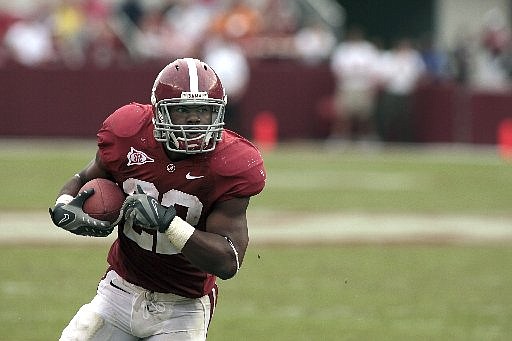DRAFT COUNTDOWNSunday: Newton rises againToday: Ingram's issueTuesday: Wonderlic concernsWednesday: Dareus vs. FairleyThursday: Replacing Peyton
Mark Ingram's biggest fault entering Thursday's NFL draft may be the era in which he plays.
Ingram put Alabama's offense on his shoulders midway through its 2009 national championship season and wound up rushing for 1,658 yards and earning the program's first Heisman Trophy. A meniscus tear forced him to sit out the first two games last season, essentially ending his chance at a second Heisman, but Ingram still ran for 875 yards and 5.5 yards per carry.
The 5-foot-9, 215-pounder is considered the most competitive running back prospect since Oklahoma's Adrian Peterson in 2007, but running backs aren't as coveted as they once were.
"You're not getting guys back in 2003 or 2001 who are lasting long and staying productive in the NFL, and that's what makes you nervous," ESPN analyst Todd McShay said. "How much value and how long are we going to get from this guy?"
The NFL had 17 1,000-yard rushers last season, and all 17 arrived in the league in 2004 or later. Peterson and Cedric Benson were in that bunch as former top-10 overall selections, but others entered amid far less fanfare.
Former Tennessee Volunteers tailback Arian Foster led the NFL last season with 1,616 yards for the Houston Texans, and he was not selected in the 2009 draft. Atlanta's Michael Turner finished third and was a fifth-round pick in '04.
Clemson's C.J. Spiller was the first tailback taken last year, going ninth overall to Buffalo, but Ingram has been projected anywhere from Miami at 15th to New England at 28th to the start of the second round.
"He's good in terms of pass protection, and he's OK as a pass catcher," McShay said. "He doesn't have that home-run-hitting ability, which is lower on the list of things that you look for, but when you're talking about a player in the first half of the first round at a position that has such a short shelf life, it starts to make you nervous."
Said Ingram: "I'm just going to do what I always do, which is prepare myself to play great football. Whoever picks me is wherever I will be glad to go. Whoever it is will get a hard worker."
The importance of landing a franchise quarterback is reflected by the draft, as 10 of the past 13 top overall picks have been players who step under center, a streak that started in 1998 when the Indianapolis Colts used the No. 1 pick on Tennessee's Peyton Manning. Georgia's Matthew Stafford and Oklahoma's Sam Bradford have been the No. 1 picks the past two Aprils, and Auburn's Cam Newton is expected to go first this time around.
It wasn't always this way, as Ricky Bell (1977), Earl Campbell ('78), Billy Sims ('80) and George Rogers ('81) put running backs in the top spot four times in a five-year stretch.
The last running back to get picked first overall was Penn State's Ki-Jana Carter in 1995. Carter needed five NFL seasons to crack 1,000 career yards.
Ingram is praised for his lateral quickness and his continuing ability to get defenders off balance, and he generates a lot of yards after contact. Those all are traits he shares with a former NFL back from the SEC who was not selected in the first half of the first round.
"You see a lot of Emmitt Smith in him," ESPN's Mel Kiper said. "He's not the game-breaker some people may want, but some people were saying the same thing about Emmitt Smith. That's why he went 17th the year he came out of college, but he became a Hall of Famer."
The former Florida Gator is No. 2 all-time in NFL touchdowns with 175, trailing only the 208 racked up by receiver Jerry Rice.
